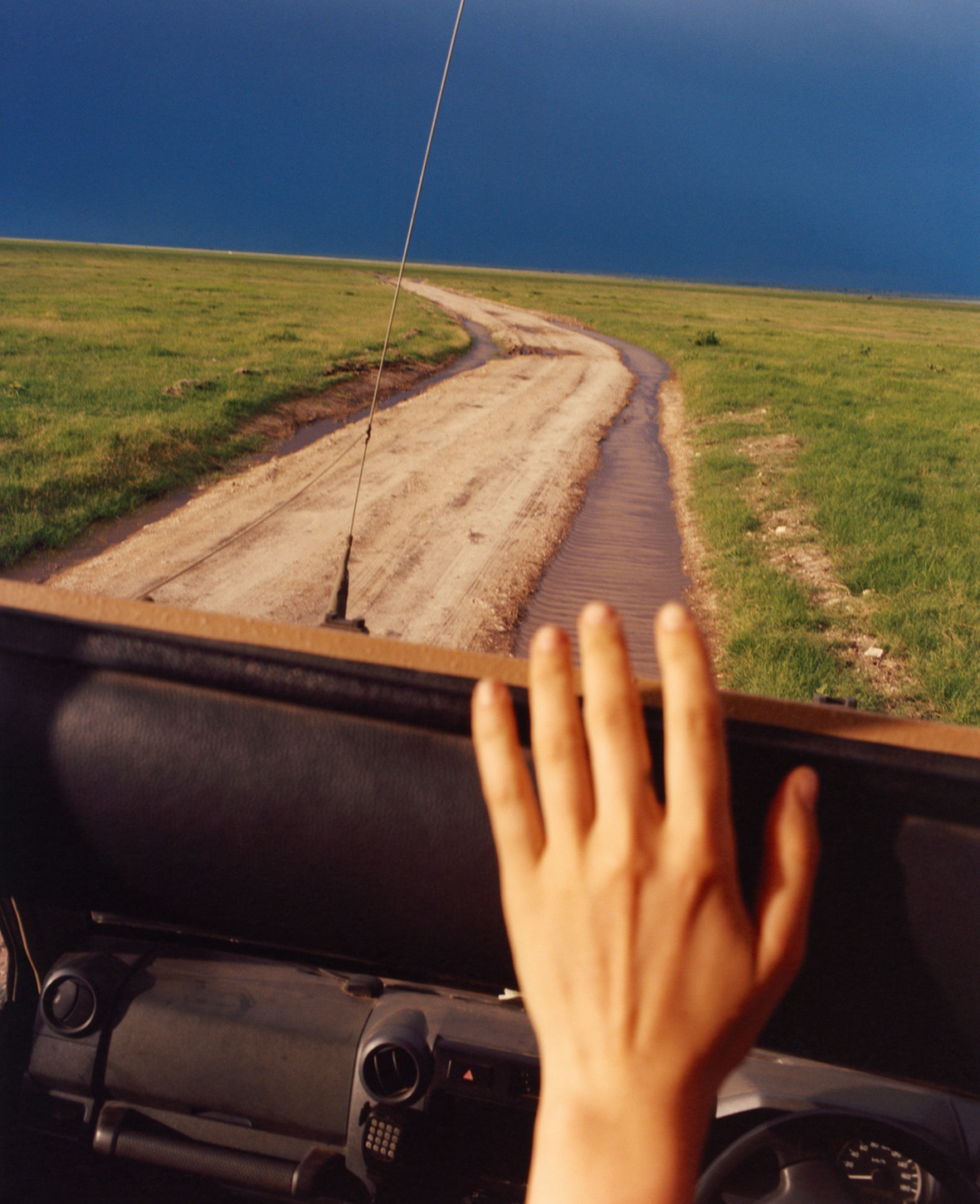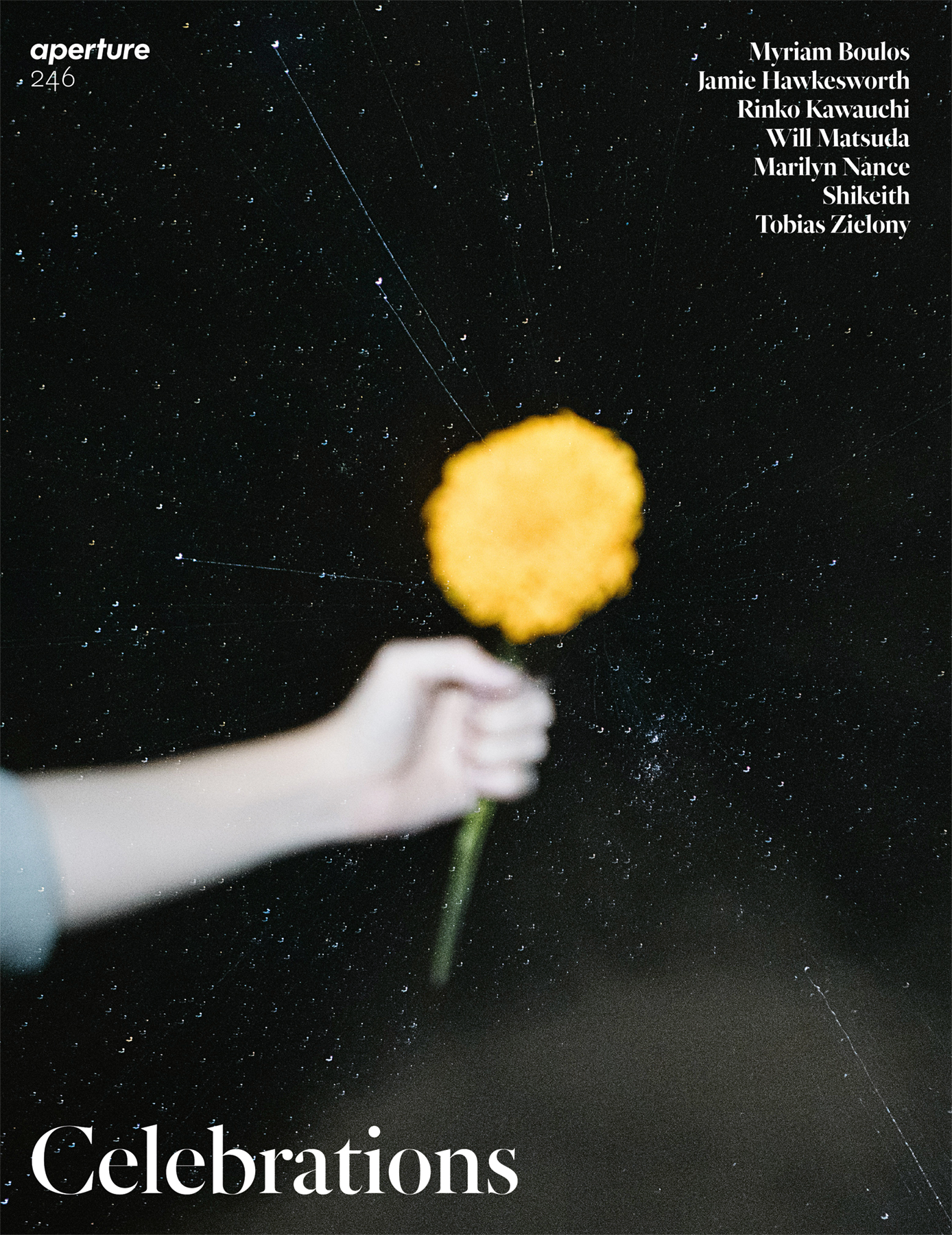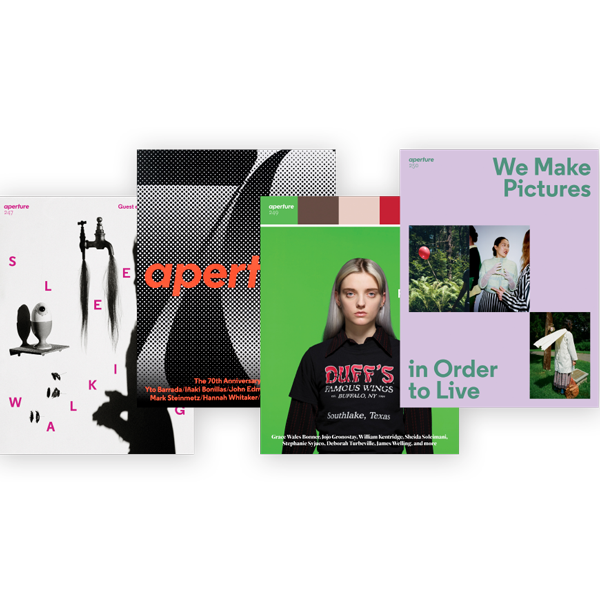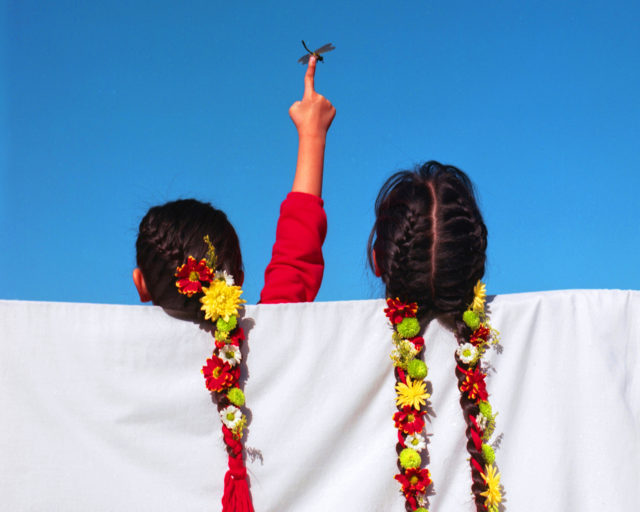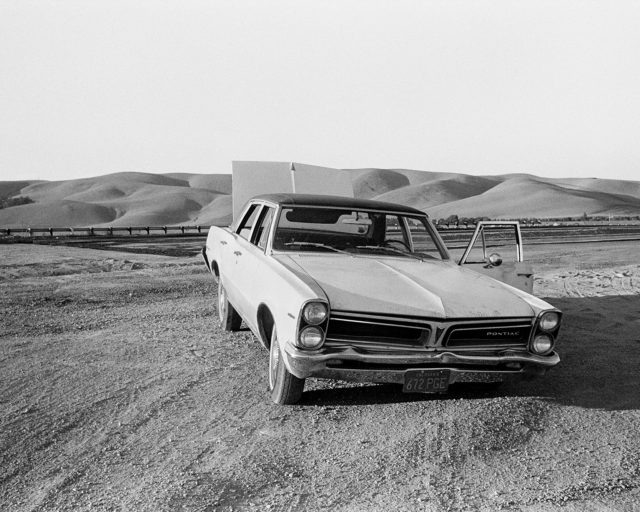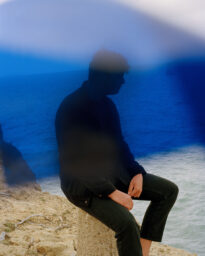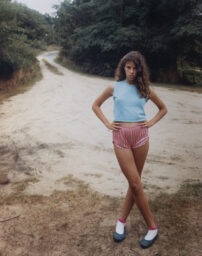Jamie Hawkesworth, Untitled, 2011–21
Courtesy the artist
A boy watches as Jamie Hawkesworth passes the couchette the child’s family is riding in on the Trans-Siberian Railway as it runs from Moscow to Beijing. As his parents play chess, the boy hangs upside down from his upper berth, poised and perfectly still as he addresses Hawkesworth’s lens. The scene evokes the strange comfort that travel sometimes produces when, close to one’s nearest in small surroundings, the world unfurls on the other side of the window.
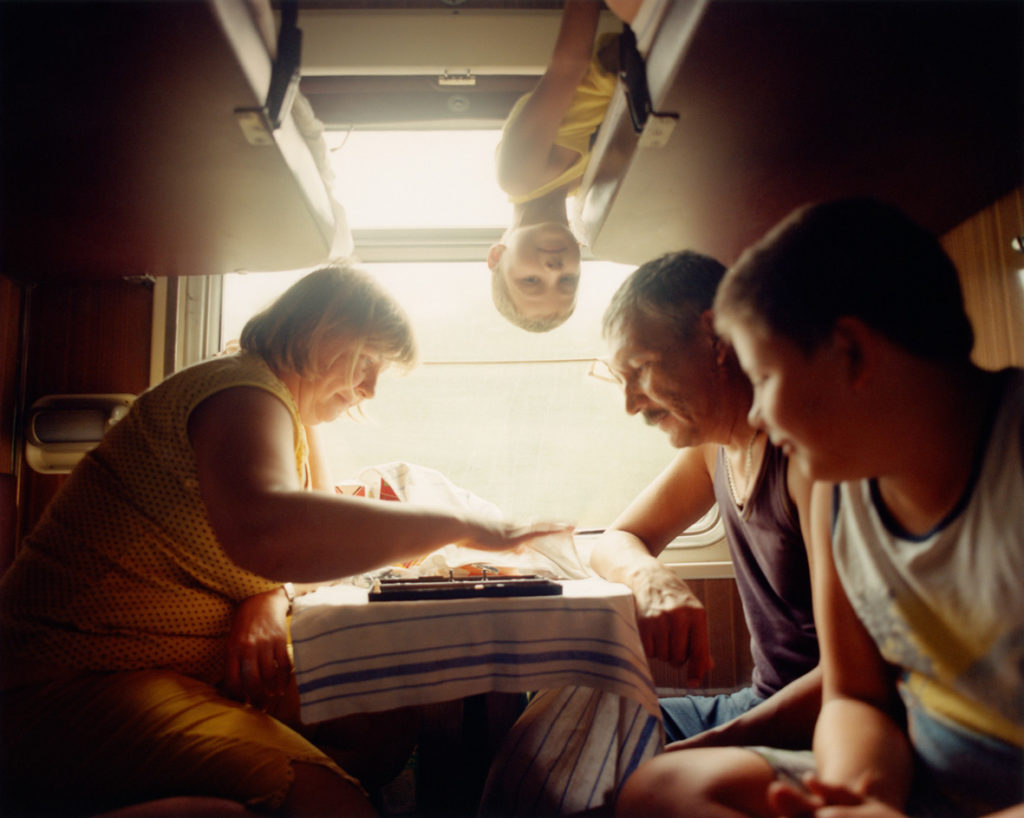
Since making his name in fashion photography, Hawkesworth has used any available space in his work schedule to go on trips to places he hasn’t visited before. This desire arises from his wanderlust about the United Kingdom, the island nation he lives in, and the vastness of the lands that lie beyond. But rather than being a means to establish himself as a travel photographer, the trips have served as opportunities to simply take photographs of people in the places he finds them. For Hawkesworth, it’s not so much about his journey, or destinations visited, but about the journeys of those he meets along the way: the world is the means to illuminate an upside-down boy as sunlight shines through the train’s window, to make us think of his view of the world in that topsy-turvy moment.
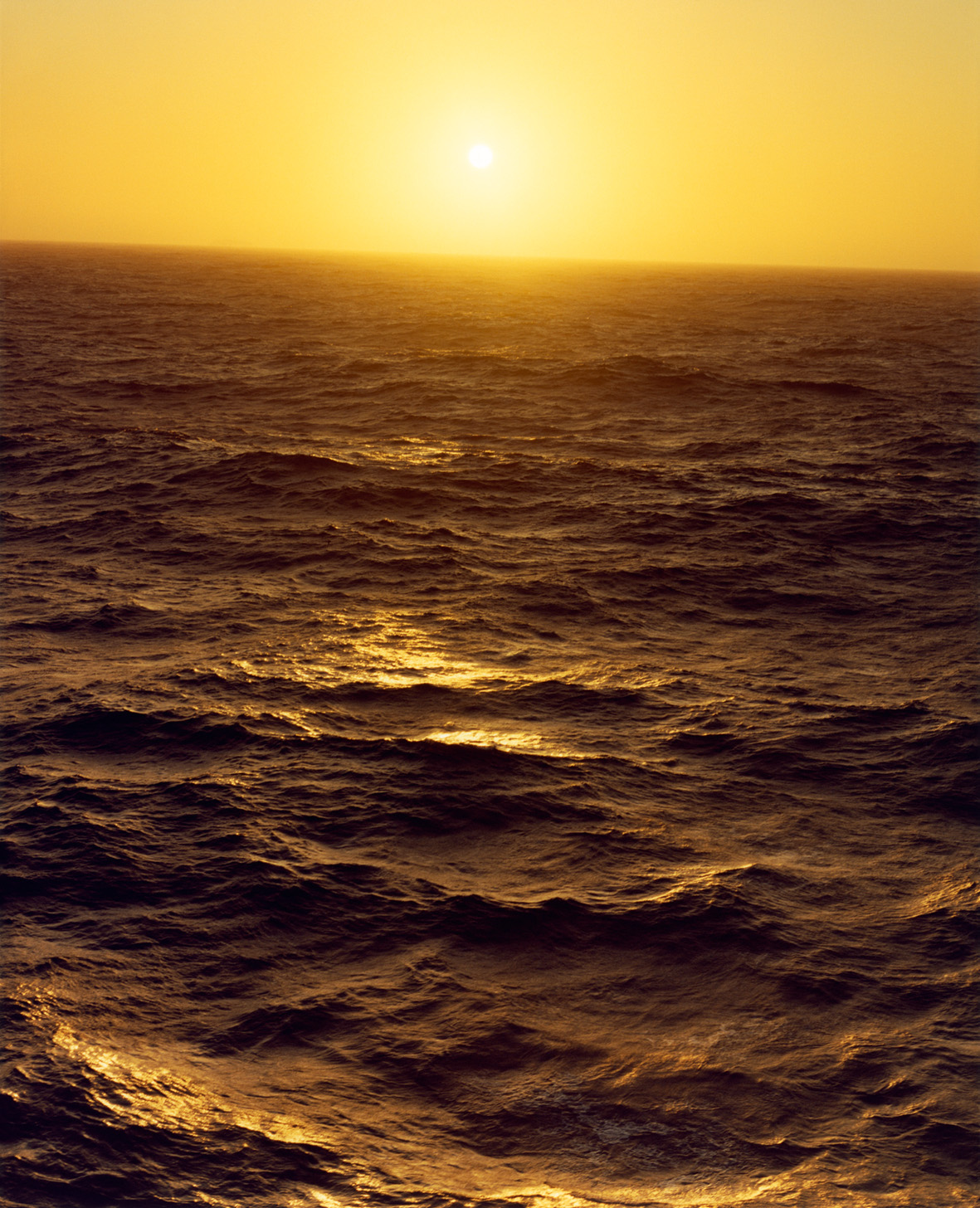
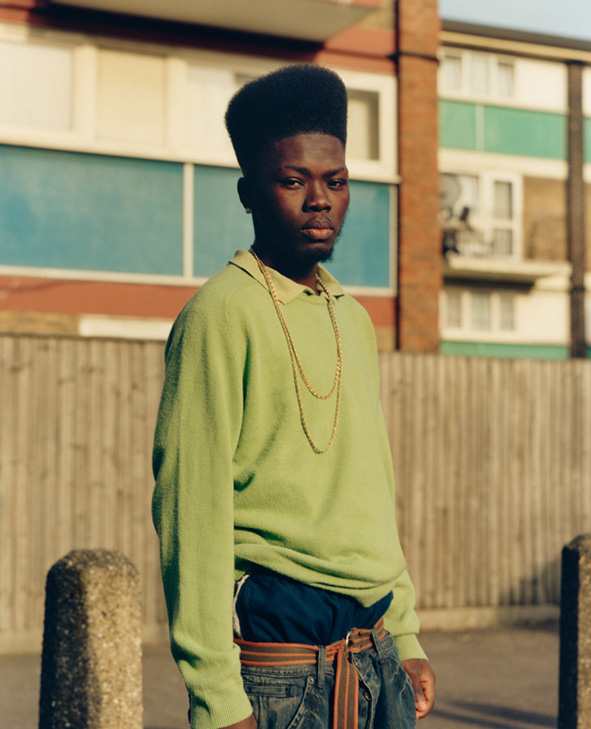
The pictures in this issue of Aperture, the majority of which are published here for the first time, are a selection of photographs taken on many of these trips. Together, they form a tender portrait of people around the globe. We are shown a checkerboard of cities—Detroit to Kerala, Los Angeles to Mumbai—and we travel along fantastical routes: Jamaica, Sweden, Mongolia, the Netherlands, the Democratic Republic of the Congo. The work, made between 2009 and 2021, is illustrated without titles, so we don’t learn the specifics of locations or when they were visited. Hawkesworth is not interested in a grand tour. Instead, we see an accumulated, and fragmented, picture of the world as it appears in the twenty-first century: the ground is dusty, the buildings are sun bleached, the sky is mostly cloudy, and it rarely rains. And in the midst is all humanity—a riot of dyed hair, tattoos, colorful mass-produced clothes—going about its business. Traces of older orders of society persist in certain Indigenous dress styles or in the layout of arable land. But what accrues, image by image, is the remarkable consistency of how individuals present themselves.
The more we see of Hawkesworth’s imagery, the more we seem alike in our multitude of differences. But this is a fiction the work raises, collapsing time and space, cultures and continents into a set of faces addressing a camera. In this process, it differs from the documentary universality found in initiatives such as Edward Steichen’s exhibition The Family of Man (1955), in which he curated a collective photo-essay about human experience.

Hawkesworth, by contrast, gives us a dreamworld from a single viewpoint about quotidian existence. The historian Ludmilla Jordanova, who has written about The Family of Man, has observed that the ordinary people who are the staple subjects for such photography projects “see through photographs because, since there are so many of them, they have long ceased to be remarkable.” What is left to them is to inhabit images that draw attention to the “selective artistry of photographs,” which they, by and large, fail to profit from. Viewed today, Hawkesworth’s work largely represents a prepandemic world; part of its charge lies in how it allows us to wander in places now less easily traveled. This body of work, which follows Hawkesworth’s celebrated photobooks, The British Isles (2021), To the Antarctic (2021), and Preston Bus Station (2017), suggests new territory for the photographer.
Hawkesworth was born in 1987 in the English county of Suffolk. He first studied forensic science at the University of Central Lancashire (founded as the Institution for the Diffusion of Useful Knowledge in 1828) before shifting to photography, having been taught to use a camera to document mock crime scenes. After failing the law exam element of the forensic-science program, Hawkesworth decided to reject the objectivity of forensics and learned to use a camera according to a creative set of concerns. “It was a bit of a whim when I switched to photography, but within a week I just completely fell in love with it,” he told me when we spoke last autumn. “For the first time ever, I could use my hands to play around with something and make something.”

In 2010, a year after graduating, Hawkesworth spent a weekend in Lancashire in northern England with his former tutor, the writer and curator Adam Murray, photographing young people at Preston Bus Station, a key example of British brutalist architecture. The portraits were published that year in a newsprint pamphlet titled Preston Bus Station, one of the first publications of the collective Preston is my Paris, founded by Murray and the photographer Robert Parkinson. In 2012, hearing that the bus station was threatened with demolition, Hawkesworth returned to Preston for a month to document it again, taking photographs and making a film. Every day, he studied the people who arrived at and left the terminus according to the timetables of the numbered bus routes, along with those who loitered all day hidden in plain sight. The large plate-glass windows of the station showed him how light moved hour by hour, illuminating the details of appearance in all manner of journeymen. The project became a pictorial symbol for local campaigners trying to save the building, with the pressure group Gate 81 securing a site-specific installation of Hawkesworth’s images in the bus station. The opposition forced the local council to abandon its redevelopment plans, and the building became a Grade 2 listed building (a building warranting preservation as being of architectural significance) only a year later in 2013.
Hawkesworth is not interested in a grand tour. Instead, we see an accumulated, and fragmented, picture of the world as it appears in the twenty-first century.
This formative undertaking taught Hawkesworth how to negotiate a portrait. “Growing up,” he says, “before I got on the phone to call someone, I would always have to practice what to say because I was quite shy. When I started to approach strangers, I’d be incredibly nervous and knew that person was also probably nervous, so it was very awkward, which I found really exciting.” Hawkesworth adds, “I very quickly learned how to talk to someone, how to use my camera under pressure, how to conduct myself so that person feels comfortable—all these millions of things in such a simple exchange.” He began photographing with a Mamiya RB67 with a 127mm lens, which he continues to use, as it was “always about trying to keep things basic.” His focus lay in the nature of the encounter over and above the securing of the picture: “I always said to myself, If I hold on to that excitement, then the pictures are always going to feel honest.”

The other contributing factor to Hawkesworth’s aesthetic style is his practice of developing and printing his own work. “The biggest thing that I got from the darkroom,” he explains, “was that once, by mistake, I opened the door a fraction and it brought this warm glow into the picture.” He turned the mistake into a stylistic feature, infusing the subject matter with a different disposition: “It was a huge part of my printing, particularly at the beginning with a project like Preston Bus Station, a very cold space. When I came back to the darkroom that technique would help me to warm up the photographs, making them feel a lot more optimistic than they were in reality. It felt celebratory of the place rather than it being a freezing cold bus station—which it was.” The project brokered a different framework for photographing people, perhaps not in the documentary tradition, but one more analogous to the contemporary art model of participatory practice, or the design model of codesign, both of which flatten out hierarchies between artists/designers and audiences/consumers through open collaboration in creation and development.
News of the Preston Bus Station pamphlet came to the attention of Julie Brown, director of M.A.P, a fashion-image agency. She made contact with Hawkesworth to request a copy and signed him at their first meeting. An ongoing collaboration with the designer JW Anderson across a number of seasons and projects soon followed, with Hawkesworth participating in Disobedient Bodies, the exhibition Anderson curated at the Hepworth Wakefield, in 2017, for which Hawkesworth photographed 123 local schoolchildren in key examples of twentieth-century and contemporary fashion designs.
Hawkesworth’s desire to resist being categorized was brought into sharp focus by the agency. “I remember them saying that they wanted the website to have my personal work in one section, fashion in the next section, and documentary here, and I was always really confused,” he says. “Why would you separate any of it?” Hawkesworth is disinterested in such divisions. “I’ve always just been plodding along, doing portraiture, traveling around the country, and then an interesting fashion project will come up, and I’ll treat that in exactly the same way, same camera, same printing, so I never really separated anything.”


Hawkesworth’s photographs of India, Kashmir, and Bhutan taken in 2019 made the Japanese fashion designer Junya Watanabe nostalgic for Asia in the midst of lockdown. For his Spring 2022 womens wear collection, usually shown at Paris Fashion Week but this time staged in Tokyo to a remote audience, Watanabe presented the models in front of large projections of Hawkesworth’s images of golden deities, monks, and mountain peaks to frame a collection that incorporated collaborations with Chinese, Thai, Nepalese, and Japanese artists and craftspeople living in Asia and around the world. It’s a poignant statement about connectedness and isolation, with both the visuals and the clothing allowing the eye to travel. Watanabe knew of Hawkesworth’s reputation through his fashion editorials in Vogue (U.S. and U.K.), Love, and the New York Times as well as advertising campaigns for Alexander McQueen and Holland & Holland. That Hawkesworth’s foothold in the space of fashion is matched by the photography he produces beyond this category is why a designer such as Watanabe finds the nonfashion/fashion intersection of his portfolio appealing.
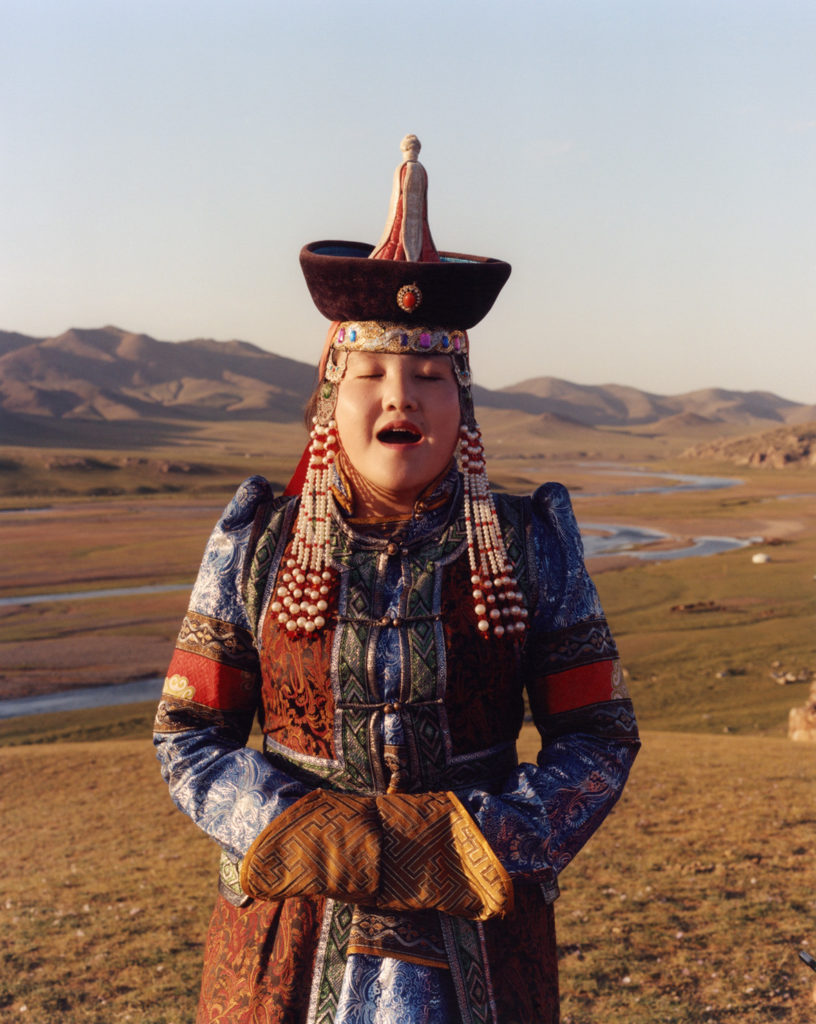
Indeed, ordinary individuals with distinct personal style permeate Hawkesworth’s most recent book, The British Isles, a three-hundred-page publication that collects the photographs Hawkesworth has taken on trips around the United Kingdom. Hawkesworth printed from the negatives in his darkroom in Shoreditch, London, over a sustained eighteen-month period. The British Isles arose out of him setting himself small journeys, he says, “where if I hadn’t been to a place, I’d just go and see who I’d come across. Just really that simple.” Keeping his observant eye on what he witnessed allowed him to perceive often-overlooked details. What the trips were not about was cataloguing a nation and a country. “When I went to Scotland, I never thought, Oh, for the next three weeks I’m going to explore the identity of Scotland, or what it is to be Scottish. I never had the idea to document Britain, it just sort of happened.”
When thinking what to call the publication, Hawkesworth remained very conscious of the word Britain in a climate of Brexit, devolution, and disunity. The title deflects a political position, merely raising “all of the little islands that I went to, plus all of the mainland.” The book contains no captions, so the lack of place names or dates produces a rounded experience of a people and land redolent of subtle seasonal transitions and temperate climate. At the book’s heart is a sequence of portraits of pupils at Christ’s Hospital school. They look like extras from a Harry Potter movie, but their uniforms are, in fact, unchanged from the school’s inception in the City of London in 1552. The private school is now in East Sussex, but it upholds its tradition of offering scholarships to academically gifted children from disadvantaged backgrounds. And it’s here that we find the just model for the country Hawkesworth was searching in, a paragon for social equity distinct from the current British government’s rhetoric of “levelling up” economic disparities as the country recovers from the pandemic.
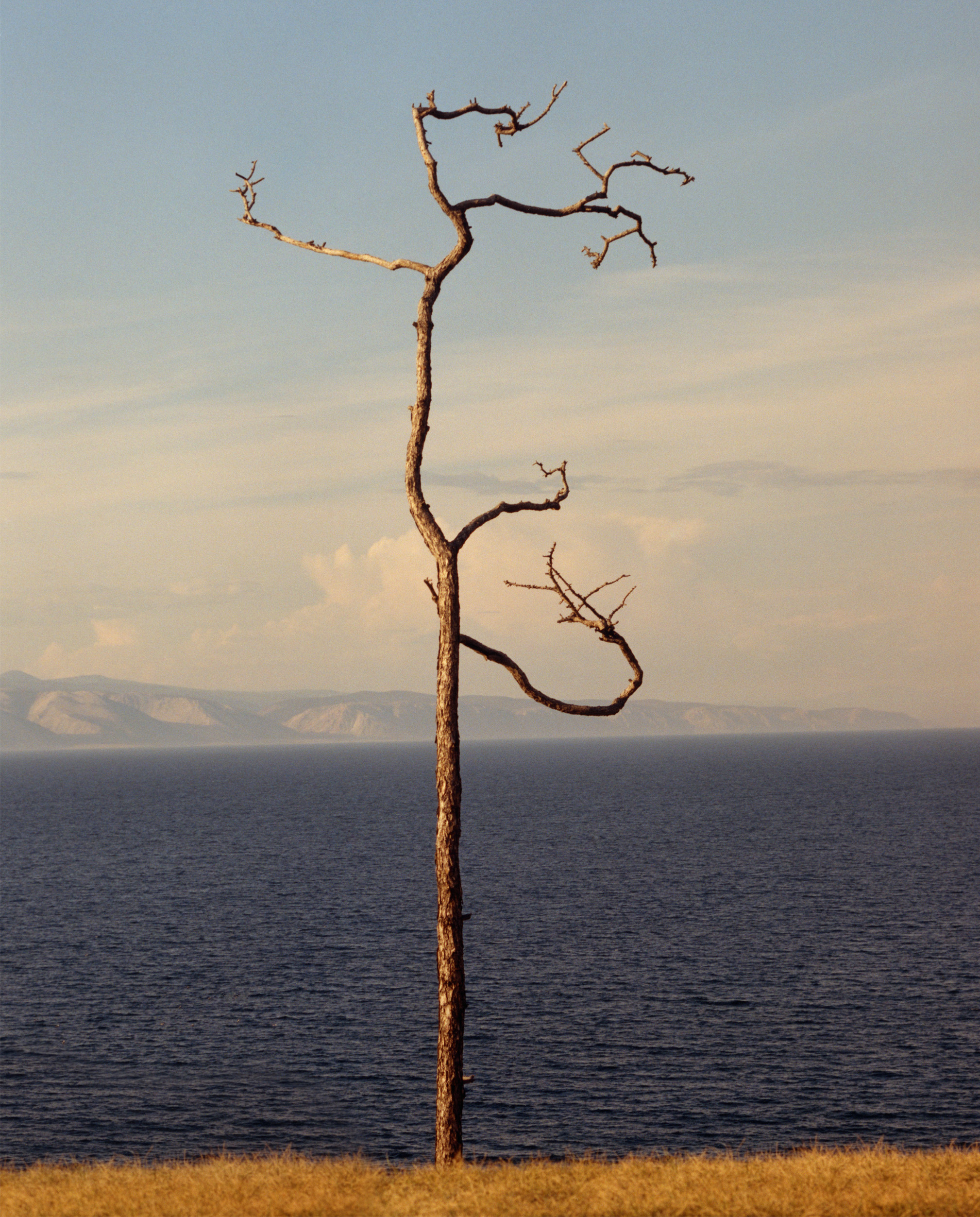
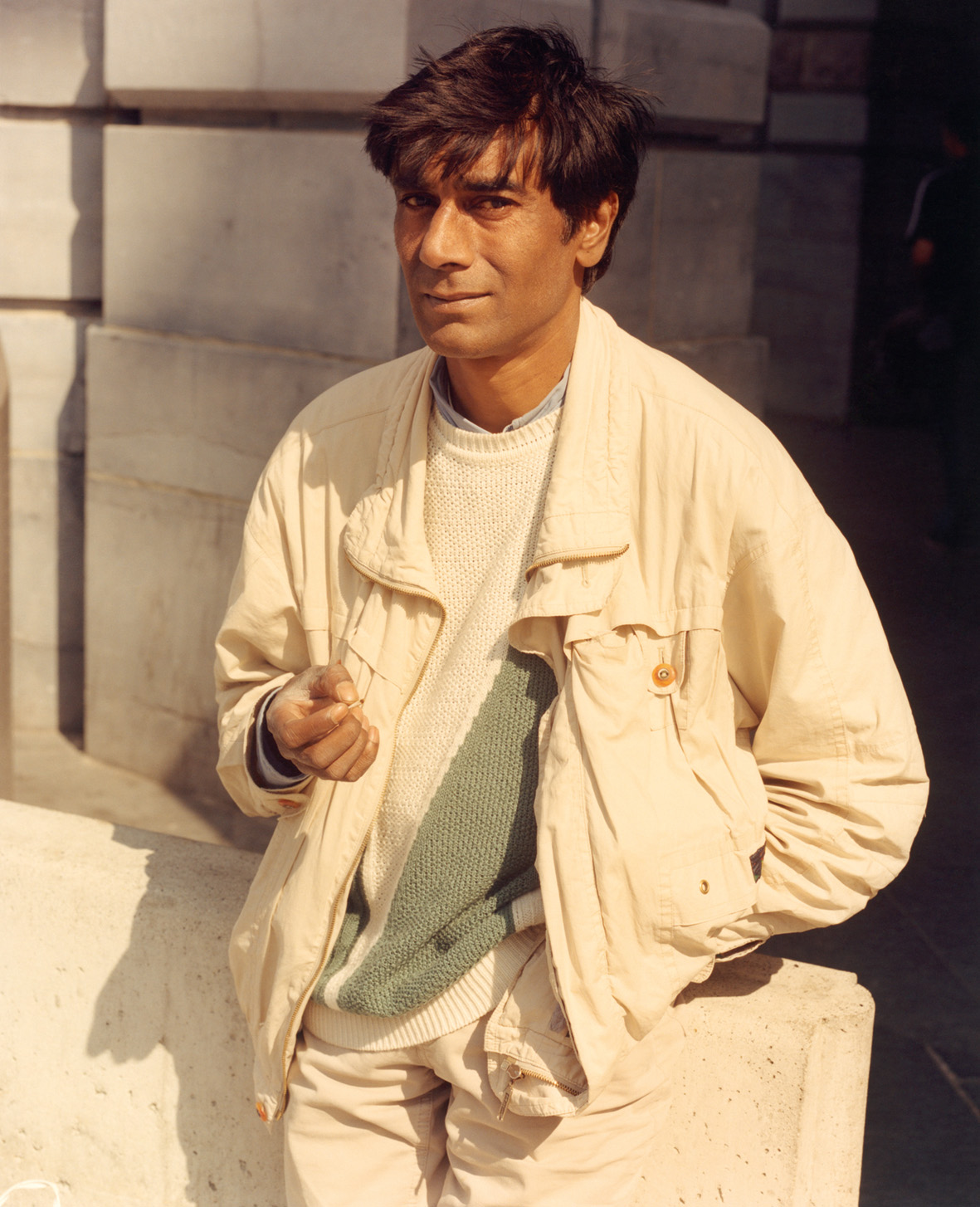
In Hawkesworth’s own education, his first year studying forensic science was where he learned to use a camera to document evidence. The course involved simulated crime-scene houses where “you are actually searching for the evidence to then photograph as it hasn’t been marked for you—you have to find it.” Was dusting for fingerprints that different from photographing people he hadn’t met before? “It is very similar in that you’re running around trying to find something, and then you photograph it,” he says. Hawkesworth’s photographs uncover as much about his subjects as the setting he finds them in, revealing faces and places, and the unseen connective tissue that binds one to the other.
Hawkesworth has worked in fashion, documented global communities, and detailed uninhabited regions, but he is unusual in resisting the trope of the glamorous photographer-explorer typified by Peter Beard, or maybe even Patrick Lichfield. In his unassuming manner and in the gentle nature of the images he produces, he has no need for a safari jacket to signal his ego or his photographic output. This is not to suggest he is unaware of such precedents. In traveling to Antarctica, he downloaded a copy of Werner Herzog’s documentary about the polar region, Encounters at the End of the World (2007), onto his phone. He explains that when you sleep on the ice, “you dig a hole, and you sleep in the hole in a special sleeping bag, and that was where I watched that documentary.” Hawkesworth’s wanderlust is as much about dreams as it is about exploration. I also get the feeling Herzog would be pleased to know of Hawkesworth’s viewing experience.
This article originally appeared in Aperture, issue 246, “Celebrations,” under the title “Around the World.”










